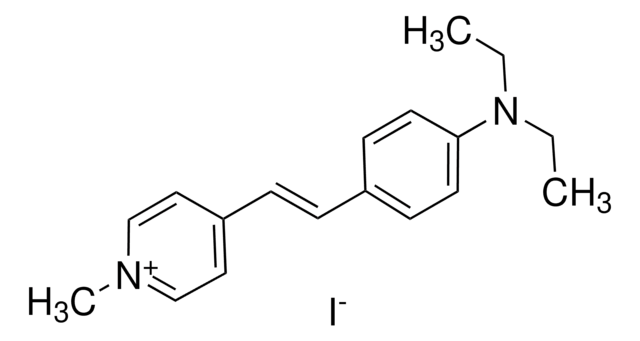This product may be stored at room temperature.
Kluczowe dokumenty
83702
Rhodamine 123
BioReagent, for fluorescence, ≥85% (HPLC)
Synonim(y):
2-(6-Amino-3-imino-3H-xanthen-9-yl)benzoic acid methyl ester
Wybierz wielkość
361,00 zł
Wybierz wielkość
About This Item
361,00 zł
Polecane produkty
klasa czystości
for fluorescence
linia produktu
BioReagent
Próba
≥85% (HPLC)
Formularz
powder
zanieczyszczenia
≤10% water
rozpuszczalność
ethanol: 20 mg/mL, clear, red
przydatność
in accordance for fluorescence
suitable for fluorescence
ciąg SMILES
Cl[H].COC(=O)c1ccccc1C2=C3C=CC(=N)C=C3Oc4cc(N)ccc24
InChI
1S/C21H16N2O3.ClH/c1-25-21(24)15-5-3-2-4-14(15)20-16-8-6-12(22)10-18(16)26-19-11-13(23)7-9-17(19)20;/h2-11,22H,23H2,1H3;1H
Klucz InChI
MYFATKRONKHHQL-UHFFFAOYSA-N
Szukasz podobnych produktów? Odwiedź Przewodnik dotyczący porównywania produktów
Powiązane kategorie
Opis ogólny
Zastosowanie
- as a substrate for P-glycoprotein (P-gp) to read out functional transporter activity in fluorescent accumulation assays[2]
- to label the cells for estimating the P-gp expression by flow cytometry[1]
- in transport studies, was added to the apical to basolateral (AB-transport) or basolateral to apical (BA-transport)[3]
- the detection of mitochondrial membrane potential (ΔΨm)[4]
Działania biochem./fizjol.
Inne uwagi
Kod klasy składowania
11 - Combustible Solids
Klasa zagrożenia wodnego (WGK)
WGK 3
Temperatura zapłonu (°F)
Not applicable
Temperatura zapłonu (°C)
Not applicable
Środki ochrony indywidualnej
Eyeshields, Gloves, type N95 (US)
Wybierz jedną z najnowszych wersji:
Masz już ten produkt?
Dokumenty związane z niedawno zakupionymi produktami zostały zamieszczone w Bibliotece dokumentów.
Klienci oglądali również te produkty
Produkty
Nitric oxide (NO) as a signal transporter in neurons, endothelial cells and in the immune system.
-
Which is the storage conditions recommend for this product?
1 answer-
Helpful?
-
-
What are the excitation and emission wavelengths for Rhodamine 123 (Product Nos. 83702 and R8004)?
1 answer-
Using ethanol as the solvent, the excitation maximum is 511 nm and the emission maximum is 534 nm. The recommended excitation and emission wavelengths in PBS are 488 and 515-575 nm, respectively.
Helpful?
-
-
Why would one select Rhodamine 123 (Product Nos. 83702 and R8004) instead of other rhodamine compounds?
1 answer-
Due to is comparatively low toxicity, Rhodamine 123 is the dye of choice for visualizing mitochondria or for cell viability measurements.
Helpful?
-
-
What is the solubility of Rhodamine 123, (Product Nos. 83702 and R8004)?
1 answer-
Rhodamine 123 is soluble in ethanol at 20 mg/mL, and has been reported soluble in ether, various fats and lipids, and has limited solubility in water (no concentration given).
Helpful?
-
-
What is the Department of Transportation shipping information for this product?
1 answer-
Transportation information can be found in Section 14 of the product's (M)SDS.To access the shipping information for this material, use the link on the product detail page for the product.
Helpful?
-
Active Filters
Nasz zespół naukowców ma doświadczenie we wszystkich obszarach badań, w tym w naukach przyrodniczych, materiałoznawstwie, syntezie chemicznej, chromatografii, analityce i wielu innych dziedzinach.
Skontaktuj się z zespołem ds. pomocy technicznej











